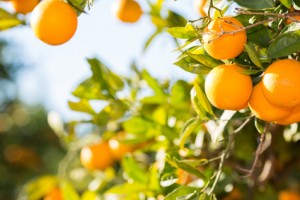

One of the greatest satisfactions is enjoying freshly picked fruit from your own yard. Keeping your citrus trees healthy and free from bothersome pests is the secret to luscious fruit. The most common pests of yard citrus plants include aphids, whiteflies, fire ants, mites, scales, plant bugs, and chewing insects like grasshoppers, katydids, and caterpillars.
It is common to find aphids and whiteflies in full attack on young, succulent leaves and shoots in the spring. A surefire signal to this situation is groups of young leaves and shoots beginning to cup curl and distort, reducing the growth of that particular growth segment. Usually the damage is done before you notice it, so it’s important to watch for early signs of infestation. Young trees can be stunted if severe infestation retards canopy development. But in most cases, trees can tolerate aphids and survive.
Whiteflies also infest young leaves and emerging sprouts, sucking the sap from these soft prebark tissues, but no leaf or shoot distortion occurs. In an epic battle between friendly orange-red fungi and invading bugs, this symbiotic fungus produces a natural chemical that parasitizes immature whiteflies. However, if you apply copper sprays to control greasy spot, melanose, and scab, the copper spray will also destroy friendly fungi.
Fire ants can kill young trees by eating the tender bark of the roots and trunk and branches, especially those of grapefruit. Certain types of mites, especially rust mites and spider mites, feed on leaves and fruit, causing a variety of symptoms referred to as stippling, silvering and russeting.
Mites can barely be seen with the naked eye but can be readily observed with a magnifying glass. Rust mites are yellow and wedge-shaped; spider mites actually look like tiny spiders. Populations of rust mites usually increase in the humid summer and again, to a lesser degree, in the fall, causing a russeting of leaves and a russeting and brown staining of fruit. While feeding on fruit, rust mites avoid shade and move towards light but avoid direct sunlight, often resulting in heavily stained fruit with clearly defined, sunlight areas without damage. Excessive damage can lead to leaf drop. Infested fruit may be smaller at harvest but may be sweeter because fruit sugar may be more concentrated due to water loss from feeding injuries. Often, a naturally occurring fungus (Hirsutella) acts as a biological control of citrus rust mites, but this beneficial fungus may not reduce rust mite populations until after damage has been done. Populations of spider mites usually peak in dry spring and fall months, causing leaves to have a lightly colored, scratched look called stippling or etching that can lead to leaf drop—especially on very susceptible cultivars like Sunburst tangerines. These pests can also cause leaf blistering and distortion and leaf drop.
Another common insect pest, are immature scales, they insert their piercing-sucking mouthparts into host tissue. They remain fixed there, feeding on plant juices and can cause moderate to severe defoliation and fruit drop. The most commonly occurring scales are “armored” or hard scales like purple scale, snow scale, red scale, and “soft” scales like Caribbean black scale and cottony cushion scale, which stimulate sooty mold fungus. Tiny wasps that act as a biological control parasitize many of these insects, but, when severe infestation occurs, chemical sprays can be applied, usually when the immature crawler stages are active.
